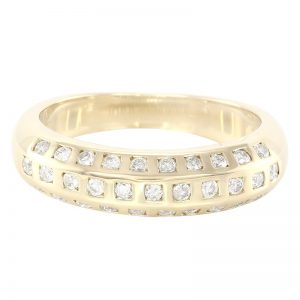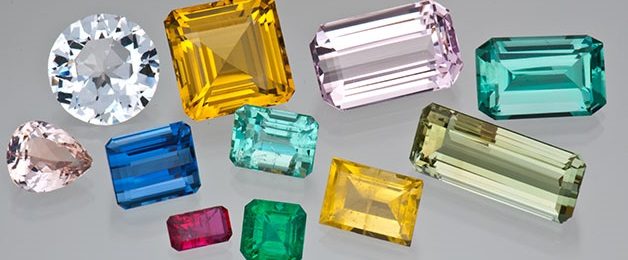Once upon a time an English Queen-
…who against advisement, insisted that the substantially large rough diamond she and her husband purchased, remain whole, instead of having it divided into two smaller stones. The stone has had three names, been housed in numerous settings, and has been coveted by the English and Dutch Royal families for generations. This is a very interesting story of power playing Royals, which includes the premiere of the spectacular Holland/Stuart Diamond.
The Glorious Revolution
In 1688 the Glorious Revolution had succeeded in ousting King James II, the last Roman Catholic monarch of England, from the throne. Members of Britain’s Protestant political elite increasingly believed him to be pro-French and pro-Catholic and of having designs on becoming an absolute monarch. So they plotted his removal. Although Mary, the daughter (and betrayer) of the deposed King – was the heiress presumptive, it was her husband William, who – with his wife’s support – set off for England to claim the throne. At their request, after the success of their campaign, William III and Mary II were – in an unprecedented move – dually crowned in 1689 as King and Queen of England.

Peace and Liberty Triumphing Over Tyranny (1716), by Sir James Thornhill-wiki
This marked the first time in English history where the country was ruled by joint sovereigns with equal power. Although Mary yielded most of her powers to her husband, he relied heavily on her. Queen Mary served ably as sovereign ruler during William’s many and extended absences from England.

Mary II Stuart (co-ruler of England with William: 1689-1694) – by Sir Peter Lely-AJU
Queen Mary II
Mary was the eldest daughter of James, Duke of York, and the future King James II of England. Mary was born in April of 1662. Upon coming of age at twenty-six, her status as heir to the throne of England required a proper marriage and the search for a suitable husband began. Enter William, Prince of Orange and Mary’s first cousin. Prince William of Orange offered a political and religious alliance for both Mary and England. In her new home, Mary became a popular figure with the Dutch people. However, their time in the Netherlands would not last for very long. Across the Pond, they had a revolution to lead.

9k-diamond-gold-ring-Rocks&Co.
A diamond in the rough
While in Holland, the newlyweds William and Mary purchased a large rough diamond. The queen ordered the rough diamond carved whole, Ignoring the advice of the seller to have the stone halved into two smaller diamonds. The resulting rose-cut pear-shaped diamond was named the “Stuart” after its owner. The diamond was set in a large brooch as the centre stone. Sadly Queen Mary would only enjoy the diamond until 1694 when an outbreak of smallpox took her life at age 32. Mary and William were childless, which meant that all of her possessions, including her jewellery, went to her husband. The widowed William died in 1702. Most of the crown jewels were originally the property of the House of Orange and returned to the Netherlands, including the “Stuart” Diamond.

Queen Anne of England-Wikipedia
A Tug of Diamond
Mary’s sister Anne was next in line to the throne of England. Believing her brother-in-law’s jewellery should remain in England, Anne sued for ownership of any item purchased by William and Mary after their marriage. The suit came too late to regain any of the jewellery already returned to the House of Orange.
Royals in exile
The pressure was on. Dutch Stadholder, Prince Willem V quickly had a contract drawn up in 1782 which stated that none of the jewellery could be sold without the permission of all the members of the House of Orange. Years later, in yet another twist of history, the House of Orange diamond collection returned to England when Prince Willem V, his wife Princess Wilhelmina and his family sought asylum, escaping the invasion of their country by the French army.
The Holland Diamond
With the House of Orange’s in temporary residence a.k.a exile across the English Channel, Princess Wilhelmina is introduced to the British jewellers Rundell & Bridge by Queen Charlotte. The Dutch Princess has several items of the family’s jewellery redesigned, including the resetting of Queen Mary’s diamond into a pendant suspended from a necklace. At this time the stone is weighed and found to be a hefty 39.75 carats. It’s also during this time that the diamond was referred to as the “Holland”. It is Likely this name change was an attempt by the House of Orange to distance the diamond from its past relationship with England. In 1851, when, during the Great Exhibition, the first world’s fair, the “Holland” was described as being “of the purest water” and weighing 36 carats, briefly referred to as the “Cone” diamond.
Once the Dutch royals were able to safely return to their home, Willem VI became Sovereign Prince and later King Willem I of the Netherlands. With the resumption of their rule, the treasures of the house of Orange were restored and the “Holland” diamond was re-engineered to be detachable from the necklace created by Rundell & Bridge.

William I of the Netherlands-wikipedia
Changing Appearances
Another inventory conducted of the jewellery in the possession of the House of Orange in 1874 listed Queen Mary’s beloved rose-cut diamond, surrounded by 22 brilliant cut diamonds.

diamond ring white gold-Rocks&Co.
In 1897, German jeweller Shurman of Frankfurt placed the diamond at the centre of a Tiara he created using other stones owned by the royal family. This tiara was worn by Queen Wilhelmina in 1898 for her coronation. It is said that the much loved Dutch Queen, preferred to reference the diamond by its origins, naming it the “Stuart Tiara”.
The mysterious diamond of many names is presumed to be in the possession of the royal family in the Netherlands but has not been seen in public for some time.
All Sources:
- http://www.langantiques.com/university/Holland_Diamond_(Stuart)
- https://en.wikipedia.org/wiki/William_and_Mary
- https://en.wikipedia.org/wiki/Glorious_Revolution
-
- Balfour, Ian. Famous Diamonds, London: Christie, Manson & Woods Ltd., 2000. Pp. 120-123.
- Streeter, Edwin W. The Great Diamonds of the World: Their History and Romance, London: George Bell and Sons, 1882. Pp. 305.
- “Mary II of England.” Biographies. Answers Corporation, 2006. Answers.com 13 Feb. 2009.
- “Mary II of England.” A Dictionary of British History. Oxford University Press, 2001, 2004. Answers.com 13 Feb. 2009.
- Netherlands – Holland. Royal Magazine, Butschal © 2008






